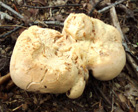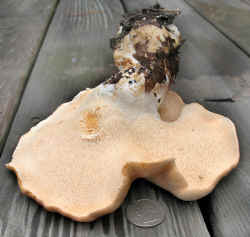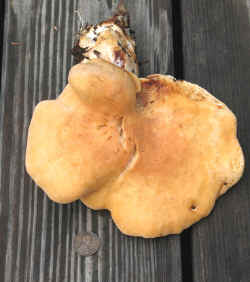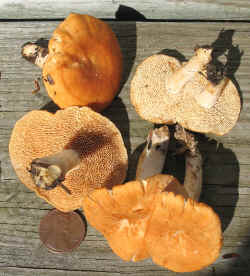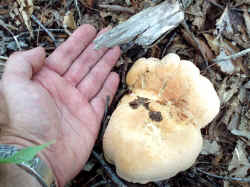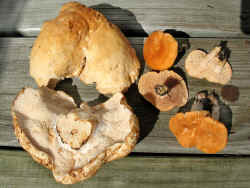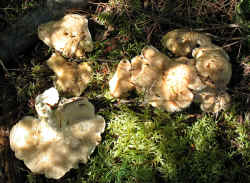|
|
A New England and Eastern Canada Edible and Medicinal Mushroom Resource |
||
|
Hedgehog/Sweet Tooth Mushroom
The hedgehog mushroom a.k.a. sweet tooth really is represented by 2 closely related species. They are close relatives of the chanterelle and their aroma is strikingly similar. These can often be found in profusion beginning in mid-summer and continuing into late fall. One really good thing about them is that bugs tend to leave them alone. During the summer that can be very refreshing since so many good looking finds can be infested during the warmer months. Cap (pileus) Hydnum repandum is 2-8 inches wide, thick, and usually convex but often irregularly shaped with lobes. Occasionally they will become flat or upturned and usually have a wavy margin. Color varies from cream to orangey brown. They may develop an orangey color when bruised. Hydnum umbilicatum cap is usually orangey brown, smaller, with a more centered stem and a sunken depression at top center. Teeth (hymenophore) Both species have whitish to light brown tooth-like structures between 1/8-1/4 in long that break off very easily. Hydnum umbilicatum teeth are usually a somewhat darker color. Stem (stipe) Hydnum repandum has a short thick stem that is usually off center and often irregularly shaped. Hydnum umbilicatum has a thinner longer more centered stem. Flesh Hydnum repandum flesh is thick, whitish, and
stains orange. Spores Both species have a white spore print. When and where to find them (ecology) Hydnum repandum is usually found around hardwoods such as Birch or Beech (and others). I have a nice stand that produces well each year under a very mature yellow birch very near my home. Usually these start showing in August and can continue well into November in mixed woods. Hydnum umbilicatum is usually found under conifers and in wetter areas during the same time span but mostly in September and October. Often you will find dozens if you find one. Last fall while looking for matsutake I stopped next to a stand of hemlocks near a lake that looked promising to me. I found a piece of black thread near the side of the road that led into the woods to a Hemlock grove in the interior. I could see that this thread led to someone's secret matsutake stand. It was too late though. I could see the holes around the hemlocks where they had been picked. Dang! With a little looking around, I left the woods happy. Nearby were more than a hundred H. umbilicatum that the matsutake hunter overlooked. I think it made them taste extra good. Preparation Both of these can be prepared in similar fashion. They are nice sautéed, fried and dried. They have a crunchy but not chewy texture. The flavor and smell is somewhat similar to chanterelles. Being much larger and thicker, Hydnum repandum can be used in more ways including microwave. Whereas I don't find Chanterelles to be great deep fried, the bigger chunkier H. repandum fries up pretty well. The smell of Hedgehogs when drying them is worth the price of admission by itself. I don't think any mushroom makes my house smell better. They don't reconstitute all that well so a mushroom powder may be the best use. Comments This one is great eating and not that hard to find during times when there may not be much around that is not buggy. The teeth make it easy to identify. Find more information here: Hydnum
repandum at MushroomExpert.com
Use of this site will constitute your acceptance of the disclaimer. Copyright 2011 Mushroom-Collecting.com. All rights reserved. |
